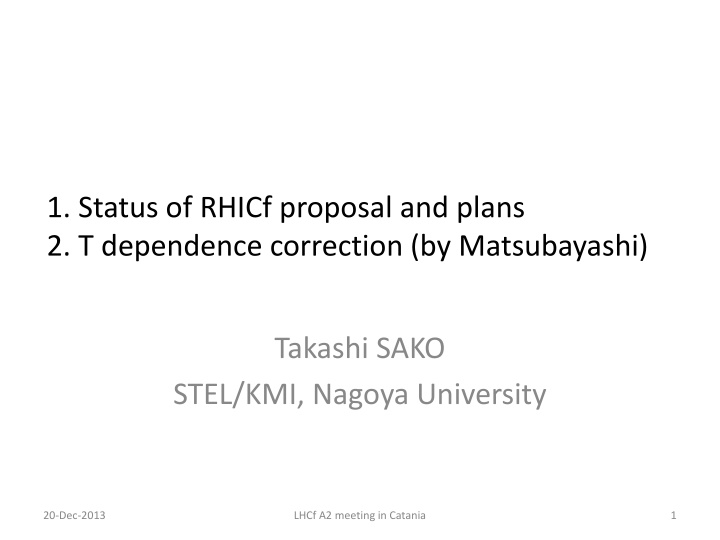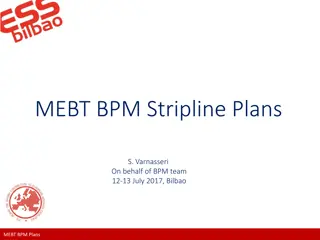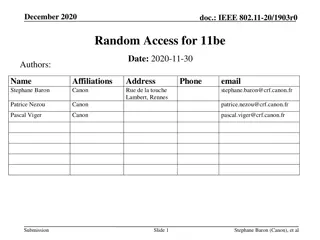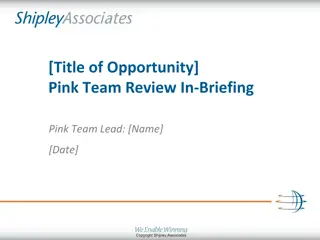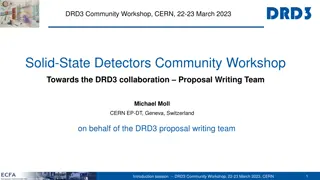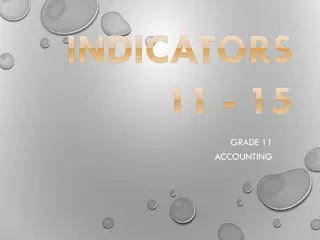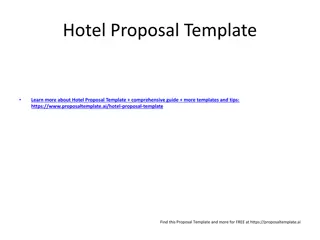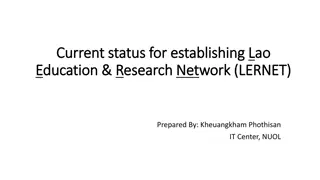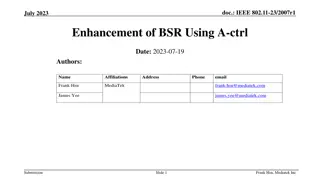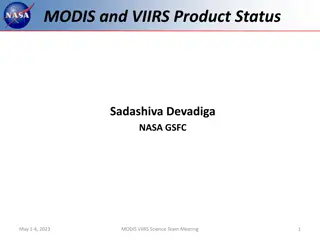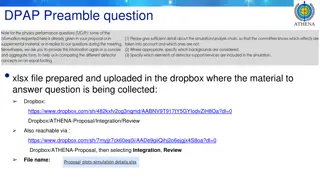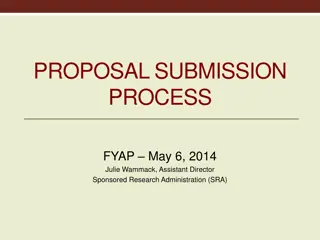Current Status of RHICf Proposal and Plans
Discussion on the RHICf proposal and plans, including T-dependence correction and physics motivations such as Feynman scaling, nuclear effects in light ion collision, and spin asymmetry in neutron production. Activities since April with submissions and presentations to PAC, preparation of proposals, and upcoming scenarios for runs in 2015-2016.
Download Presentation

Please find below an Image/Link to download the presentation.
The content on the website is provided AS IS for your information and personal use only. It may not be sold, licensed, or shared on other websites without obtaining consent from the author.If you encounter any issues during the download, it is possible that the publisher has removed the file from their server.
You are allowed to download the files provided on this website for personal or commercial use, subject to the condition that they are used lawfully. All files are the property of their respective owners.
The content on the website is provided AS IS for your information and personal use only. It may not be sold, licensed, or shared on other websites without obtaining consent from the author.
E N D
Presentation Transcript
1. Status of RHICf proposal and plans 2. T dependence correction (by Matsubayashi) Takashi SAKO STEL/KMI, Nagoya University 20-Dec-2013 LHCf A2 meeting in Catania 1
RHICf 2
3 Physics Motivations 1. Feynman scaling RHIC 500GeV pp gives a similar xF-pTcoverage to LHC 7TeV run than LHC 900GeV 2. Nuclear effect in the light ion collision Realization of world-first light ion collision 3. Spin asymmetry in the forward neutron Innovated at RHIC LHCf type detector with a better position resolution than ZDC gives better measurements 3
LHC single gamma data (900GeV pp / 7TeV pp) Preliminary pT (GeV/c) LHCf 7TeV RHICf 500GeV LHCf 900GeV 2 1 0 200 E (GeV) 100 4
Nuclear modification factor E 0and En (200 GeV p-p / p-N) DPMJET3 QGSJET-II EPOS DPMJET3 QGSJET-II EPOS p-p p-N p-p p-N 0 n 100 E(GeV) 100 E(GeV) (p-N/p-p) (p-N/p-p) 1 1 0 n 0 0 5 100 E(GeV) 100 E(GeV)
Spin asymmetry AN for very forward neutron production Y. Fukao et al., Phys. Lett. B650, 325-330 (2007). [hep-ex/0610030]. Polarized p p at 62, 200 500 GeV pT B. Z. Kopeliovich, et al. , PRD84, 114012 (2011). No ANat backward ANonly at very forward Need finer pT resolution ! 6
Activity since April May: submission of LOI to RHIC PAC June: Presentation at PAC by Itow Recommendation to submitting a proposal Home works; LHCf detector really optimum? why low energy experiment? (more quantitative evaluation of Feyman scaling study) September: Draft beam schedule of RHIC for next few years (see next slide) No 500GeV p-p in the next few years October: Preparation of a short letter to PAC by Sako, Itow and Goto (later slides) November: Request from PHENIX to explain the idea of RHICf December: Presentation of Goto at PHENIX meeting and Executive Committee (later slides) Possible scenarios for 2015-2016 run in two cases; 200GeV and 500GeV are necessary Further discussions in Feb 7
Letters to PAC and PHENIX We suppose to operate at the PHENIX IP SCHEDULE 2015 LHC 13 TeV 2016 RHICf using LHCf detector Pilot run We need some helps for combined DAQ with PHENIX 2017 Preparation for the dedicated detector 2018, 2019 RHICf using dedicated detector Main physics run PRIORITY 1. 500GeV pp for Feynman scaling study 2. Asymmetry study together with pp 3. 200GeV pN, NN 9
Answer from PHENIX Goto san presented only physics motivations and beam requests on 10-Dec PHENIX needs a few pages of possible scenarios for two cases of 2015-2016 operation in the EC meeting on 13-Feb CASE1: 500GeV p-p; needs interests inside the group CASE2: 200GeV p-p (p-A); relatively easier According to the scenarios, they will discuss how they include it in their operation proposal submitted to 2014 PAC Collaboration style can be discussed freely (no discussion on 10-Dec) 10
Our answers to give in Feb (TBD) 500GeV p-p is the first priority Limiting the discussion on the 2016 run, we will join even only with 200GeV p-p (p-A) because This is a pilot run for 2018-2019 LHCf detector does not have ideal coverage Collaboration style Independent is ideal, but Inside PHENIX is OK (Japanese OK, but Italian?) Paper with 400 authors we do not like Shift for the main PHENIX physics not easy Other items? 11
Why new detector? Less limitation by beam-pipe shadow than LHC We lose chance to detect low energy pi0 We miss 0 degree during high eta scan LHCf detector is optimized to TeV (sampling frequency) Beam pipe shadow RHIC aperture r = 10cm Why new DAQ? Reducing cabling cost and time Unifying to the PHENIX DAQ => reducing the efforts to prepare full DAQ and operation PMT signal => PHENIX ADC, maybe simple Silicon or SciFi => need some works DAQ in the tunnel depend on the radiation 0 degree 12
Option to the position sensors Using current sensors Detector is well known Need R&D to cooperate with the PHENIX DAQ Using a PHENIX silicon sensors Detector to be studied Maybe easy for DAQ A possible candidate; Silicon-pad used in the PHENIX Muon Piston Calorimeter Extension (MPC-EX) 62mmx62mm array of 1.8mmx15mm pads 1.8mm interval OK? arXiv:1301.1096v1 13
Action Items before February Sako will prepare and circulate scenarios in January Agreement about the requests for the collaboration style Some studies to evaluate Feynman scaling study. At least pi0 spectra at RHIC and LHC with realistic statistical errors using different models Sako will visit BNL in February (someone from Italy?) After February; DAQ especially silicon part (realistic than SciFi) 14
T dependence 15
Method: 2-step correction Fixed to the catalog value (-0.3%/K) 16
T measurement for most PMTs (HIMAC: To use multi-ch HV supply. Not a beam test.) PMT holders modified for T sensors attached to all PMTs < > = 57min; no PMT dependence 17
T results 18
Environment Temperature T LHC, env Tampon the TAN Power of amp was always ON Shifted to Tcalorimeterwhen everything switched off Analysis period in this study T SPS,env T at the electonics rack 20
Summary plot (w.r.t. #RUN) M (MeV) Stability of g g 142 135 136 137 138 139 140 143 141 p mass peak at Arm2 (Fill 1013~Fill1122) 3000 3500 4000 4500 Fill D D raw data T UP + LHC-SPS correction T UP correction 5000 RUN# 21
Summary plot (w.r.t. Date) mass peak at Arm2 (Fill 1013~Fill1122) p Stability of 143 142 141 Mgg (MeV) 140 139 138 137 raw data temperature correction LHC-SPS correction (CENTER) LHC-SPS correction (OLD CENTER) LHC-SPS correction (-5 mm) 136 135 C) PMT temperature( 25 20 04/01 04/08 04/15 04/22 04/29 05/06 05/13 05/20 22
What is Residual? p Stability of mass peak at Arm2 (Fill 1013~Fill1122) 143 Mgg (MeV) 142 141 140 139 138 raw data temperature correction LHC-SPS correction (CENTER) LHC-SPS correction (OLD CENTER) LHC-SPS correction (-5 mm) 137 136 135 04/01 04/08 04/15 04/22 04/29 05/06 05/13 05/20 PMT Temperature Change 28 C) PMT temperature( 26 24 22 20 18 04/01 04/08 04/15 04/22 04/29 05/06 05/13 05/20 TIME LHC2010 Dose Monitore 0.8 Dose (Gy) 0.7 Dose High Sensitivity Arm2 0.6 0.5 0.4 0.3 0.2 0.1 0 04/01 04/08 04/15 04/22 04/29 05/06 05/13 05/20 Time 23
Homeworks What is the effects of Hybrid, SciFi FEC? T coefficients for all PMTs (now catalog value - 0.3%/K) Same measurements ( T) and analysis for Arm1 What is the difference between Arm1 and Arm2? Radiation damage After radiation damage Some works in Firenze needed when we construct the detectors. Do you have a chiller? 24
